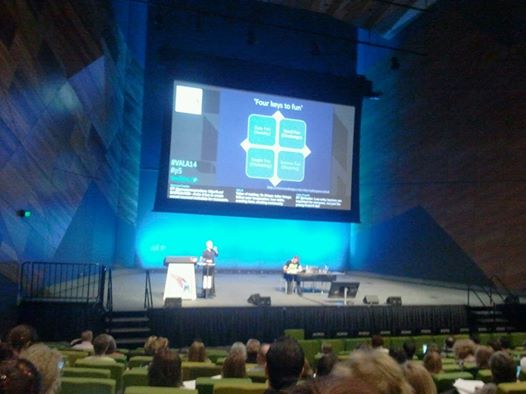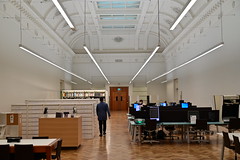VALA Presentation
- http://www.vala.org.au/vala2014-proceedings/802-vala2014-plenary-5-ridge
- http://www.slideshare.net/miaridge/glam-makers-valamiaridgev5-for-posting
Maker movement, maker culture, and maker spaces are buzz words for people in libraries creating stuff. This is an equally important service for a library to provide as knowledge and information services. A maker attitude is perhaps the best term to use. Think of the Curiosity Show (http://www.curiosityshow.com.au/) which taught kids to make things. Maker spaces / fab labs provide share equipment, tool libraries, and allow personal space access (e.g. http://lj.libraryjournal.com/2013/05/future-of-libraries/making-room-for-innovation/). It can be as simple as photography. It can be music such as singalong Sound of Music (http://www.singalonga.net/sound-of-music/).
Collecting items which can have an outlet in social media. Social media lends itself to a significant amount of content creation. Creative work gives you lived experience, and can connect you with the past.
Crowdsourcing involves close looking at collection items, this can create connection and curiousity, develop an interest in the content and can lead to an interest in history.
At the Metropolitan Museum of Art they have 3D printing activities, you can create your own 3D artwork, even combine artworks such as statues. This enables learning from engagement. Museum of Victoria offers 3d printing (http://museumvictoria.com.au/about/mv-blog/may-2013/3d-printing-at-smartbar-/). Make or fix stuff using Sugru (http://sugru.com/), consumer technology product putting capability in the hands of the users. Use Makey Makey (http://www.makeymakey.com/) to build a banana piano (this works by using everyday objects as an interface).
Creating visualisations is an important way to work with data (http://labs.cooperhewitt.org/2012/exploring-shape-collections-draft/). In the 1980s kids learned programming by typing in code from magazines, then by changing this code found they could manipulate the outcomes. Now they can use Scratch (http://scratch.mit.edu/). (My son is learning via http://www.codecademy.com/ – RH). Through the process of making, you gain an understanding of the tacit knowledge required to complete creative tasks.
Programming is one of those hard tasks that require you to fail many times before you can succeed. Creative work is fun while complex tasks like programming could be called “hard fun”. Hard fun provides a challenge, it requires self-motivation, it requires time to learn the skill to participate, and follows a cycle or failure and repetition until success can be achieved.
A collaborative programming project within a 1 week period came up with this result: http://serendipomatic.com/ which uses APIs to connect to cultural collections. See also http://cosmiccollections.pbworks.com/w/page/69153/FrontPage
Casual gaming is seen as the best way to motivate crowdsourcers and to harness crowdsourcing energies (http://museumgam.es/).
Labspace open educational resources (http://labspace.open.ac.uk/). British Library joined Flickr Commons (http://blog.flickr.net/en/2013/12/16/welcome-the-british-library-to-the-commons/).
Creative work requires ownership of the material and creative freedom, such as freedom to choose. Fiero describes the feeling of success at completing a creative task, particularly triumph over adversity.
You can start by making your own collection on Pinterest. Learn from the experiences of others. Edit Wikipedia. Knowledge is not only facts, but also the method of things. Creativity can be difficult to define, and therefore difficult to justify. There is an element of risk in creativity. In order to be creative, freedom must be allowed. In one Auckland school, all schoolyard rules were stopped, and the school found various improvements as a result (http://www.stuff.co.nz/national/education/9650581/School-ditches-rules-and-loses-bullies).
See also:
- http://deborahfitchett.com/blog/2014/02/bringing-maker-culture-to-cultural-organisations
- http://openobjects.blogspot.co.uk/2014/02/bringing-maker-culture-to-cultural.html






3 responses to “Mia Ridge on the Maker Movement”